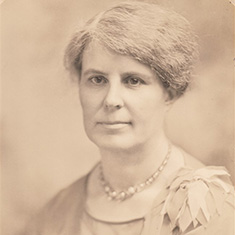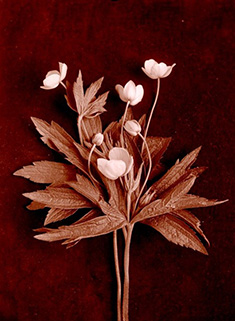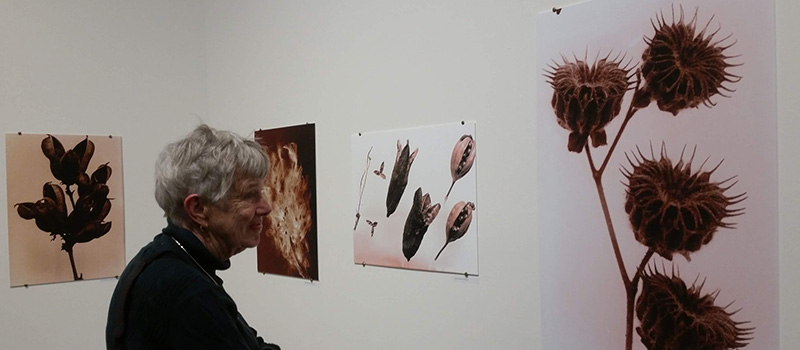Nature photographer Cornelia Clarke 1909 gaining acclaim thanks to a community effort
 Cornelia Clarke 1909
Cornelia Clarke 1909
October 21, 2021 — With about 1,200 of her photographs published in magazines, encyclopedias, books, and newspapers, what Cornelia Clarke 1909 captured with her camera was widely seen in the early 20th century.
Yet Clarke was largely unheralded in her hometown of Grinnell both during her life and in the eight decades following her death. A volunteer endeavor by Grinnellians has raised awareness about Clarke’s talent and brought her photography to light, resulting in newfound appreciation, including Clarke’s upcoming induction into the Iowa Women’s Hall of Fame.
“The news about the Hall of Fame was very exciting given that her story was lost and overlooked for so long,” says Monique Shore ’90, systems administrator at Drake Community Library in Grinnell. “The tidbits that we have been able to find about her personality is that she was very quiet and reserved. She didn’t toot her own horn by any means. I thought it was fascinating that it wasn’t until her death that most people in Grinnell learned about how widely her work had been published.”
Through a 2019 museum exhibit, online photography galleries and articles, and reproductions of Clarke’s work hanging around town, Grinnell residents are honoring one of their own.
“Not surprising the Grinnell community is pretty spectacular about identifying and honoring real art, industry, and Grinnellians,” says Ann Igoe, vice president of the Grinnell Historical Museum. “Cornelia worked hard her whole life to perfect what she did.”
From cats in suits to plants and flowers
 Clarke with her father,
Clarke with her father,
Ray Alonzo Clarke
In his research of Clarke, professor emeritus Dan Kaiser unearthed numerous details about her life. She was born July 4, 1884. Her mother, Cornelia Shepard, sadly died within a few hours of her birth. Her dad, Ray Alonzo Clarke, raised Cornelia on a farmstead. Because her father practiced photography as a hobby, a camera was familiar to Cornelia at an early age.
A 1904 Grinnell High School graduate, Clarke was originally part of the College’s class of 1908. But she spent most of 1906-07 traveling in Europe with her father, all the while putting her camera to use, Kaiser notes. Soon after graduating from the College, Clark and her father moved to 1322 West Street in Grinnell, which would become the setting for many photographs, including Peter and Polly.
Clarke trained her cats, Peter and Polly, to wear miniature suits and dresses, posed them with remarkable small-scale furniture, and then photographed them to tell a story. The prints were first published in 1911 in the Country Life in America journal. Brief captions outlined a tale of two kittens, who grew up together, fell in love, married, had kittens of their own, did adult-like chores, and grew old together.
“I just marvel at the time it must have taken to train those cats, have them pose, and capture those shots,” Shore says. “She must have been incredibly patient.”
In his blog about Clarke, Kaiser writes that interest in Clarke’s photographs was instantaneous. So many readers expressed pleasure at seeing Clarke’s images, the journal published a handful of similar photographs two months later. Clarke soon made contact with Elizabeth Hays Wilkinson, a Pittsburgh college teacher who authored several children's books, and the two women collaborated to produce a book version of the story.
 Four images by Cornelia Clark featuring her two cats dressed in clothing and doing human activities. The descriptions left to right: Finally came their wedding day, Polly was a lovely bride, She made a fine housekeeper, and She did her own washing.
Four images by Cornelia Clark featuring her two cats dressed in clothing and doing human activities. The descriptions left to right: Finally came their wedding day, Polly was a lovely bride, She made a fine housekeeper, and She did her own washing.
Kaiser notes that by this time Clarke was using her camera to record many other images, including, for example, photographs Grinnell College commissioned of the campus and its buildings. Clarke also began taking photos of the natural world.
Quickly her reputation for capturing objects in nature spread (although many times she would bring plants or flowers back to her West Street house to avoid the wind blowing on them), with her specialty being insect and plant life. Her work appeared in numerous publications, such as American Photography, World Book Encyclopedia, Nature Magazine, along with all sorts of newspapers and textbooks.
“Viewing Clarke’s botanical images today, we are reminded of the artistry and skill she brought to the task,” Kaiser wrote in nomination materials to the Women’s Hall of Fame. “Cornelia Clarke brought to her life’s work an artist’s eye as well as a scientist’s commitment to accuracy.”
The re-discovery
Clarke was a volunteer and honorary curator of the College’s herbarium – a collection of preserved plant specimens and associated data used for scientific study. Handwritten items that Clarke categorized, classified, and preserved can still be found in the herbarium today, Igoe says.
 This image Clarke took of an
This image Clarke took of an
anemone plant was one of the
glass negatives re-discovered
at the State Historical Society
of Iowa.
Photos of some of the specimens were blown up and used by professor Henry Conard in his botany classes for many years. Upon Clarke’s death in 1936, she bequeathed more than 3,000 negatives to Conard. He later took the glass negatives to the University of Iowa where he continued to teach. But when he retired to Florida, he left the negatives in Iowa City.
Many years later some of the glass plate negatives were discovered by Mary Bennett, special collections coordinator at the State Historical Society of Iowa, who, as luck would have it, had been a botany major herself and realized what the negatives were. It was presumed they belonged to Conard. But upon his research of Clarke, Kaiser suspected they were Clarke’s creation. Kaiser and Igoe took a trip to Iowa City in 2017 to find out.
“There were 14-15 cardboard boxes full of these glass plate negatives,” Igoe says. “We opened the first box and saw the negatives in various stages of condition. If there was a print alongside the glass plate negatives, it had Cornelia’s name on the back of it. So, we knew they were hers. We got very excited.”
Kaiser, Igoe, and Sally Timko ’18, a Grinnell Historical Museum intern at the time, returned to Iowa City several times to index the negatives and place them in archival storage materials.
“We spent about 5 hours at a time looking at each negative and deciding its content and condition,” Igoe says. “We were especially interested in finding any that had a Grinnell connection. At one point, we saw an image that had a house behind it, a house still standing on East Street.”
The State Historical Society allowed the Grinnell Historical Museum to borrow 100 of the negatives for digitization, with the agreement that the museum could use the digital images produced. Rachel Fore ’18, Drake Community Library digital archive assistant at the time, scanned the glass slides and tweaked the lighting. Seventy-six of those photos can be viewed on the Iowa Historical Library and Archives Flickr account.
The images were enlarged and put on display at the Grinnell Art Center Stewart Gallery and the Drake Community Library. “It was wonderful to see all of her work side-by-side and to see the reactions from people witnessing her photos for the first time,” Shore says. “By blowing it up to that size, you can see the expansion of miniscule things like dandelion seeds. It really amplified her skill.”
 Grinnell resident Mary Schuchmann takes a look at Cornelia Clarke’s botanical images during the 2019 Cornelia Clarke Forgotten Photographs exhibit at Stewart Gallery.
Grinnell resident Mary Schuchmann takes a look at Cornelia Clarke’s botanical images during the 2019 Cornelia Clarke Forgotten Photographs exhibit at Stewart Gallery.
Several of Clarke’s prints remain hung up around the library. Some of Clarke’s photos have been put on mugs and greeting cards to further promote her work. In addition, Shore created a Wikipedia page for Clarke.
“Being able to celebrate Cornelia and find joy in that work she left behind all these years later is a wonderful thing,” Shore says.
Hall of Fame worthy
To highlight women’s heritage and recognize their important contributions to society, the Iowa Commission on the Status of Women established the Iowa Women’s Hall of Fame in 1975. Each subsequent year, the Commission and the Iowa Department of Human Rights welcome four women into the Iowa Women’s Hall of Fame, paying tribute to them and setting them forth as role models for others
Grinnell College, Drake Community Library, and the Grinnell Historical Museum banded together to nominate Clarke for this honor. As well as a detailed biographical sketch, numerous supporting materials, and a comprehensive list of Clarke’s published photographs pulled together by Kaiser, letters of support were offered by Raynard S. Kington, former Grinnell College president; Chris Jones, special collections librarian and archivist of the College; Marilyn Kennett ’83, director of the Drake Community Library; and Bennett, the beforementioned State Historical Society special collections coordinator.
While the Iowa Commission on the Status of Women passed on choosing Clarke in 2018, she was chosen as part of the class of 2021 inductees along with Roxann Marie Ryan of Cresco, former Iowa commissioner of public safety and assistant Iowa attorney general; Donna Reed of Denison, Academy Award winning actress and advocate for peace; and Jan Mitchell of Marshalltown, 1997 Iowa Teacher of the Year and the 2019 Iowa Latino Hall of Fame Robert D. Ray Award for Equity and Justice recipient.
The quartet will be honored during a virtual celebration at 10 a.m. on Nov. 6. The public is invited to watch the ceremony via the Iowa Department of Human Rights’ Facebook page.
“My guess is that she wasn’t a person who sought the spotlight,” Shore said about Clarke. “The Hall of Fame might have made her uncomfortable, but it always is good to be acknowledged for your work.”
— by Jeremy Shapiro